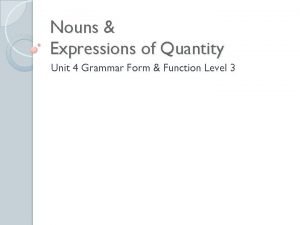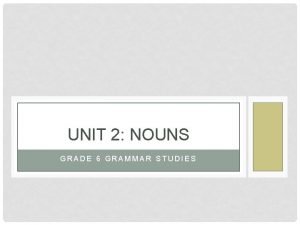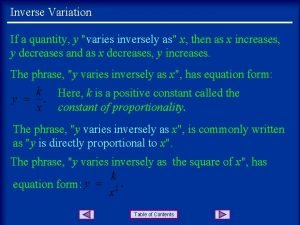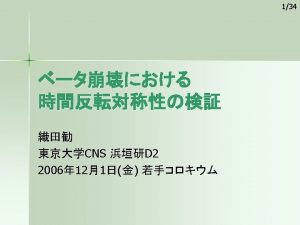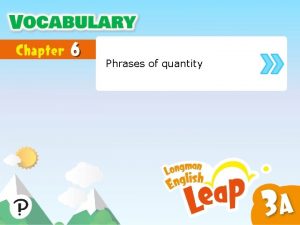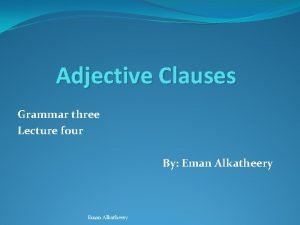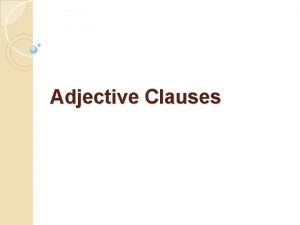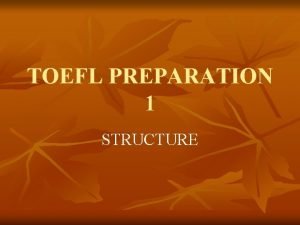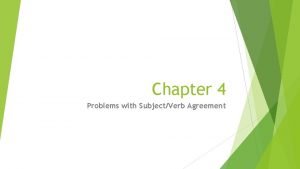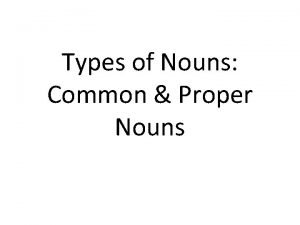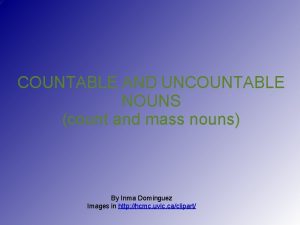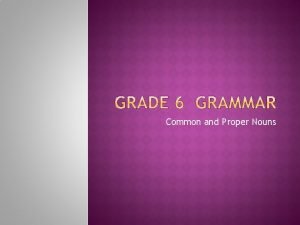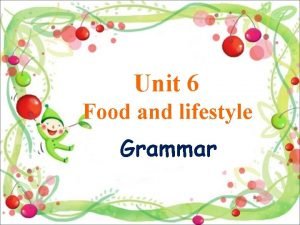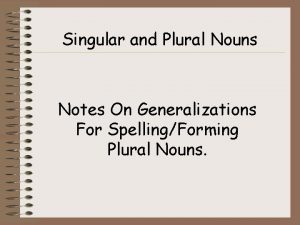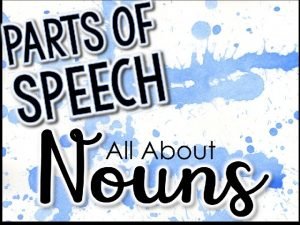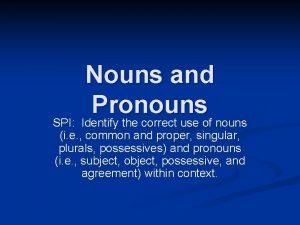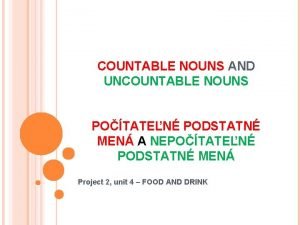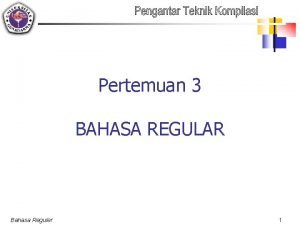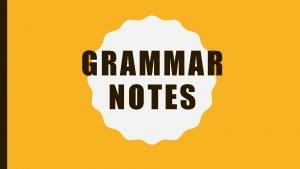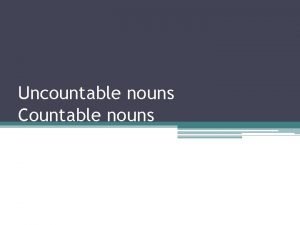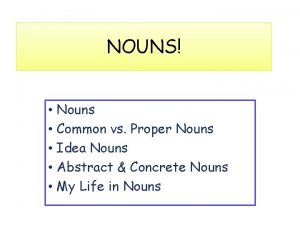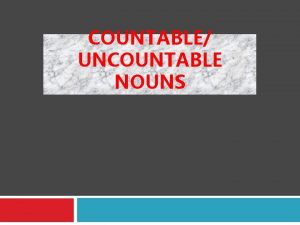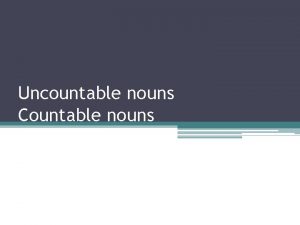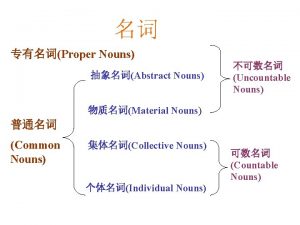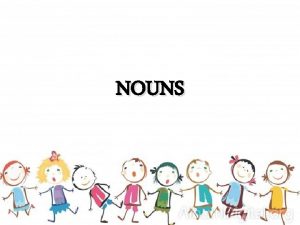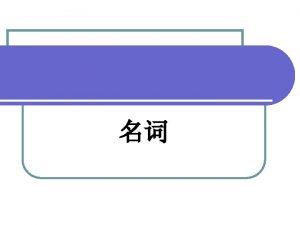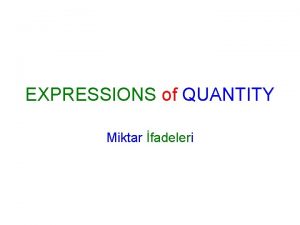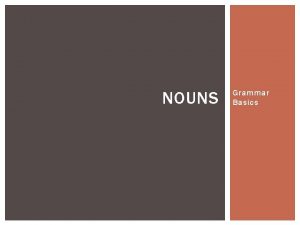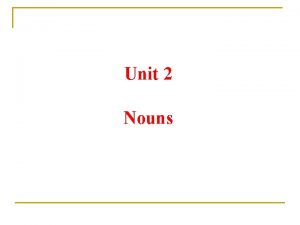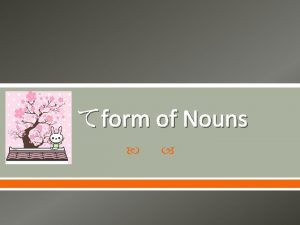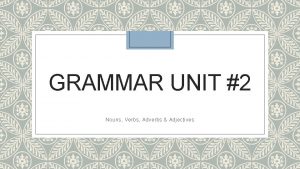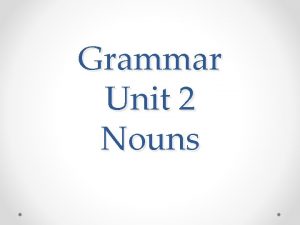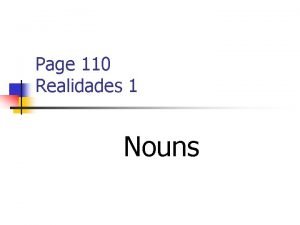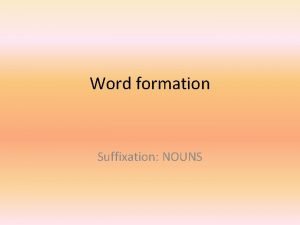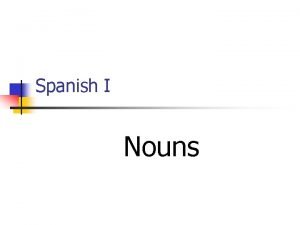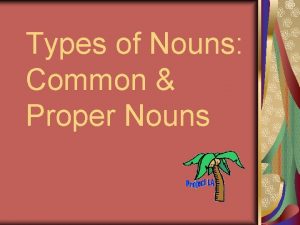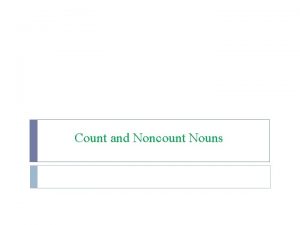Nouns Expressions of Quantity Unit 4 Grammar Form























- Slides: 23

Nouns & Expressions of Quantity Unit 4 Grammar Form & Function Level 3

Regular Plural Nouns vs. Irregular Plural Nouns Click on the correct spelling of these REGULAR plural nouns. WRONG bookes Correct – factory >> factories Correct – shelf shelves >> shelves Correct – books >> books WRONG factorys WRONG shelfes Click for next slide.

Regular Plural Nouns vs. Irregular Plural Nouns Click on “What’s the rule? ” to see the grammar. Add “-s” to most singular What’s the rule? nouns to make them plural. books factories Change “y” to “i” and What’s the rule? add “-es” shelves Change “f” to “v” and What’s the rule? add “-es” Click for next slide.

Regular Plural Nouns vs. Irregular Plural Nouns Click on the correct spelling of these IRREGULAR plural nouns. WRONG gooses Correct – mouse mice>> mice Correct – children >> children Correct – goose geese>> geese WRONG mouses WRONG childs Click for next slide.

Regular Plural Nouns vs. Irregular Plural Nouns Click on “What’s the rule? ” to see the grammar. Sometimes change “oo” to “ee” – need to. What’s memorize thewhen rule? (ex. , boots is a regular noun). mice children geese Sometimes change the vowels to make it plural – “ou” to “i” (ex. , What’s the rule? house is a regular noun that changes to houses). Sometimes add a syllable What’s the rule? to some nouns – “ren” Click for next slide.

Regular Plural Nouns vs. Irregular Plural Nouns Click on the correct spelling of these IRREGULAR plural nouns. WRONG serie Correct – series>> series Correct – sheep >> sheep WRONG sheeps Correct – aircraft >> aircraft WRONG aircrafts Some nouns have the same What’s rule? form. singular andthe plural Click for next slide.

Regular Plural Nouns vs. Irregular Plural Nouns Click on the correct spelling of these IRREGULAR plural nouns. Correct – cactus cacti>> cacti Wrong cactuses Wrong curriculums Correct – curriculum curricula >> curricula Correct – thesis >> theses thesises Wrong Some nouns come from Latin or Greek and the. What’s plural endings come from the rule? those languages. Click for next slide.

Regular Plural Nouns vs. Irregular Plural Nouns Click on the correct spelling of these IRREGULAR plural nouns. Correct – a pairjeans of jeans >> jeans Wrong jeans' Wrong shortses Correct – a pair of shorts >> shorts Correct – economics >> economics no plural economicses Wrong Some nouns are only plural and some Whatare areonly thesingular. rules? nouns Click for next slide.

Regular Plural Nouns vs. Irregular Plural Nouns Click on the correct spelling of these IRREGULAR plural nouns. Both are correct plurals – we onlypeople use “persons” in legal language. Both are correct plurals – we onlypersons use “persons” in legal language. The plural of “person” is usually theuse rule? “people, ”What’s but we can “persons” in legal language. Click for next slide.

Possessive Nouns & Possessive Phrases with “Of” Click on the grammatically correct sentences. Both are correct – The woman’s dress is possessives can be in front of beautiful. plural or singular nouns. The woman’s dresses are possessives can be in front of beautiful. plural or singular nouns. Suzy –is. Add wearing her Correct an apostrophe ( ‘ ) + “-s” to singular mother’s hat. nouns. Suzy is wearing Incorrect – needher an apostrophe (‘) mothers hat. Incorrect – need an Today is my parent’s apostrophe ( ‘ ) after the wedding anniversary. plural noun “parents” Correct – need an Today is my parents’ apostrophe ( ‘ ) after the wedding anniversary. plural noun “parents” Click for next slide.

Possessive Nouns & Possessive Phrases with “Of” Click on the grammatically correct sentences. Both are correct – for singular nouns in “-s” you can Thatthat wasend. Chris’s plan. add “ ‘s “ or just an apostrophe. Both are correct – for singular nouns end. Chris’ in “-s” plan. you can Thatthat was add “ ‘s “ or just an apostrophe. Correct – Add an apostrophe ( ‘ ) That is Kate and Ben’s + “-s” to the last noun only in a house. possessive phrase. That is Kate’s Ben’s Incorrect – onlyand need one apostrophe house. ( ‘ ) Incorrect – need an The children’ toys are here. apostrophe ( ‘ ) + “-s” Correct – need an apostrophe ( ‘ ) + “-s” because “children” does The children’s toys are here. not end in “-s” even though it is plural. Click for next slide.

Possessive Nouns & Possessive Phrases with “Of” Click on the grammatically correct sentences. Both are correct – You can omit That’s not my phone. It’s the noun after the possessive noun IF the Pete’s. meaning is very clear. Both are correct – You can omit That’s not my phone. It’s the noun after the possessive phone. noun IF Pete’s the meaning is very clear. Both are correct – With things The title of this book is “A and locations we can use the of Two Cities. ” “of”Tale possessive phrase or “ ‘s”. Both are correct – With things The book’s title is “A Tale and locations we can use the of Two phrase Cities. ” “of” possessive or “ ‘s”. Both are correct – With things The world’s problems are and locations we can use the serious. “of” possessive phrase or “ ‘s”. Both are correct – With things The problems of the world and locations we can use the “of” are serious. possessive phrase or “ ‘s”. Click for next slide.

Compound Nouns (a noun) + (a noun) = (a compound noun) **“hair” + “brush” = hairbrush **“can” + “opener” = can opener **“two” + “hour” = two-hour exam Click on the correct spelling. Correct – toothbrush >> toothbrushes Wrong teethbrushes Correct – brother-inlaw >> brothers-in-law brother-in. Wrong laws Form the plural by adding “-s” to the second. What noun except therules? “in-law” type. are the Then add “-s” to the first noun. Click for next slide.

Compound Nouns Click on the correct spelling. Correct – the number makes it plural so you don’t add “-s, ” two-hour exam do use a hyphen. two Wrong hours exam With a number in the compound What’s rule? expression, use athe hypen, but do not add an “-s”. Click for next slide.

Count Nouns & Noncount Nouns Count nouns – can be counted Noncount nouns – cannot be separated to count Click on the nouns to see which category they fit. Some words can fit in both categories. rice weather Count Nouns man crime love coffee Noncount Nouns Click for next slide.

Count Nouns & Noncount Nouns Count nouns – can be counted Noncount nouns – cannot be separated to count Click on the squares to see which category they fit. Some can fit in both categories. Can use Have ONLY singular form Always ONLY singular verbs Count Nouns Have singular & plural forms some/any/many/few / a few/a lot of Takes singular OR plural verbs Can use some/any/much/little /a lot of Can use a/an and numbers Noncount Nouns Can. NOT use a/an and numbers Click for next slide.

“Some” and “Any” Click on the grammatically correct sentences. Both are correct – Use “some” and I“any” plural nouns and havewith some paper. noncount nouns Both are correct – Use “some” and “any” with and I don’t haveplural any nouns paper. noncount nouns Correct – Use “some” in positive There are some messages sentences and “any” in negative for you. sentences usually. There any messages for Incorrect you. Incorrect He never has some time. Correct – Use “any” after negative words like He never has any time. “never/seldom/rarely/hardly/ without” Click for next slide.

“Some” and “Any” What’s the difference between these questions? Use “any” when you expect a negative don’t know Do weanswer have or any cake? what to expect. Use “some” when you expect the answer “yes” or you want to Canto. I be have some cake? influence someone to say “yes. ” What does “any” mean in this sentence? You can buy soup any It doesn’t matter at at which supermarket you buy soup. supermarket. Click for next slide.

“Much/Many, ” “A Few/A Little, ” “Few/Little, ” “A Lot Of” Click on the grammatically correct sentences. Correct – Use “many” with plural There are many apples. count nouns (or “a lot of”) Wrong There are much apples. There isn’t much butter. noncount nouns (or “a lot of”) Correct – Use “much” with Incorrect There are many butter. Correct – Use “few” with plural count nouns There are Wrong little bananas left. There are few bananas left. Click for next slide.

“Much/Many, ” “A Few/A Little, ” “Few/Little, ” “A Lot Of” Click on the grammatically correct sentences. Correct – Use “much/many” in We had justas muchfun affirmative sentences after as they did. “too/as/so/very” We had justas littlefun as Wrong they did. Correct – Use “a little” with I still havea little work to noncount nouns --a“ little/ a do. meanings few” have positive Correct – Use “little” with noncount nouns – “little/few” I have little work to do. have negative meanings I still have. Incorrect a few work to do. Wrong I have few work to do. Click for next slide.

Each/Each (One) Of/Every One Of/Both Of/ All/Al Click on the grammatically correct sentences. She is carrying a bag in Wrong every hand. Correct – Use “each” for two She is carrying a bag in things or people, “every” for each or hand. three more Every student must be on time. << Use “every” to mean “all” – to talk about a group Use “each” when talking about individual items or people >> The teacher called each student’s name. Click for next slide.

Each/Each (One) Of/Every One Of/Both Of/ All/Al Click on the grammatically correct sentences. Correct – Use “each of” and Each one of the sisters “every one of” with plural count wore thenouns same clothes. Every sisters wore the same Wrong clothes. Every one of answers was Wrong correct. Every one of your answers Use “the/those/these/your” with was pluralcorrect. count nouns Wrongwere good. Both of movies Correct – Use “both” OR “both of Both movies were good. the” to talk about two things Click for next slide.

Each/Each (One) Of/Every One Of/Both Of/ All/Al Click on the grammatically correct sentences. All of the news sound Wrong positive. All of the news sounds Correct – Use a singular verb with “all” + noncount noun positive. All Americans like hamburgers. << Use “all” + noun in a general context Use “all of the” + noun in a specific context >> All of the Americans I know like hamburgers. Click for next slide.
 Nouns and quantity expressions
Nouns and quantity expressions Lesson 2 nouns proper common and collective
Lesson 2 nouns proper common and collective Examples of scalar
Examples of scalar Difference between scalar and vector
Difference between scalar and vector Quantity has magnitude only
Quantity has magnitude only Vary inversely
Vary inversely Scalar vector tensor
Scalar vector tensor Quantity expressions
Quantity expressions Expression of quantity in adjective clause
Expression of quantity in adjective clause An old man was fishing next to me was muttering to himself
An old man was fishing next to me was muttering to himself Skill 24 adjectives and adverbs
Skill 24 adjectives and adverbs Make verbs agree after expressions of quantity
Make verbs agree after expressions of quantity Write countable) or (uncountable) apple
Write countable) or (uncountable) apple What is the difference between concrete and abstract nouns
What is the difference between concrete and abstract nouns Mass countable or uncountable
Mass countable or uncountable Common and proper noun paragraph
Common and proper noun paragraph Four tomatoes
Four tomatoes Noun number singular and plural
Noun number singular and plural Count nouns and noncount nouns
Count nouns and noncount nouns Plural nouns y gender nouns
Plural nouns y gender nouns Common noun
Common noun Quantifiers vysvetlenie
Quantifiers vysvetlenie Ekspresi reguler adalah
Ekspresi reguler adalah Notes on nouns
Notes on nouns
